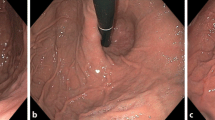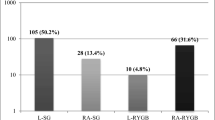Abstract
Background
The main clinical consequence of sliding hiatal hernia (SHH) is gastroesophageal reflux disease (GERD). Endoscopy and barium swallow X-ray are commonly used to diagnose SHH. We aimed to assess the clinical utility of endoscopy and X-ray in the diagnosis of SHH in morbidly obese patients before and after gastric bypass (GBP).
Methods
Ninety-two patients underwent reflux symptoms evaluation, upper gastrointestinal endoscopy, and barium swallow X-ray before and 6 months after banded GBP. The performance of endoscopy in diagnosing SHH was assessed, taking X-ray as reference. Endoscopy and X-ray were tested as predictors of SHH with GERD.
Results
SHH was more prevalent when characterized by X-ray than endoscopy either before (33% vs. 17%; P = 0.017) or after GBP (26% vs. 7%; P = 0.001). Endoscopy showed low sensitivity (≤40%) and high specificity (≥94%) in diagnosing SHH. Before GBP, more patients with SHH had GERD compared to patients without SHH using either X-ray (83% vs. 58%; P = 0.016) or endoscopy (94% vs. 61%; P = 0.009). After GBP, only patients with radiologic evidence of SHH showed higher prevalence of GERD compared to patients without SHH (50% vs. 26%; P = 0.037). SHH patients also reported weekly or daily vomit more often than patients without SHH (59% vs. 32%; P = 0.026).
Conclusions
In morbidly obese patients, X-ray is superior to endoscopy in diagnosing SHH either before or after banded GBP. In patients treated with this technique, the utilization of X-ray may help in the management of reflux symptoms and frequent vomit.


Similar content being viewed by others
References
Gordon C, Kang JY, Neild PJ, et al. The role of the hiatus hernia in gastro-oesophageal reflux disease. Aliment Pharmacol Ther. 2004;20:719–32.
Zhu H, Pace F, Trapè E, et al. Prevalence of hiatal hernia and its influence of gastro-oesophageal reflux. Eur J Gastroenterol Hepatol. 1994;6:393–7.
Vakil N, Van Zanten SV, Kahrilas P, et al. The Montreal definition and classification of gastroesophageal reflux disease: a global evidence-based consensus. Am J Gastroenterol. 2006;101:1900–20.
Kahrilas PJ, Lin S, Chen J, et al. The effect of hiatus hernia on gastro-oesophageal junction pressure. Gut. 1999;44:476–82.
Mittal RK, Lange RC, McCallum RW. Identification and mechanism of delayed esophageal acid clearance in subjects with hiatus hernia. Gastroenterology. 1987;92:130–5.
Sloan S, Rademaker AW, Kahrilas PJ. Determinants of gastroesophageal junction incompetence: hiatal hernia, lower esophageal sphincter, or both? Ann Intern Med. 1992;117:977–82.
Fornari F, Fucilini LM, Risson C, et al. Contribution of standard oesophageal manometry in sliding hiatal hernia: From the gastro-oesophageal pressure gradient to the diagnosis. Dig Liver Dis 2009; doi:10.1016/j.dld.2009.04.012.
Kahrilas PJ, Kim HC, Pandolfino JE. Approaches to the diagnosis and grading of hiatal hernia. Best Pract Res Clin Gastroenterol. 2008;22:601–16.
Mittal RK. Hiatal hernia: myth or reality? Am J Med. 1997;103:33S–9S.
Boyce HW. Endoscopic definitions of esophagogastric junction regional anatomy. Gastrointest Endosc. 2000;51:586–92.
Trujillo NP, Slaughter RL, Boyce HW Jr. Endoscopic diagnosis of sliding-type diaphragmatic hiatal hernias. Am J Dig Dis. 1968;13:855–67.
Canon CL, Morgan DE, Einstein DM, et al. Surgical approach to gastroesophageal reflux disease: what the radiologist needs to know. Radiographics. 2005;25:1485–99.
El-Serag HB, Graham DY, Satia JA, et al. Obesity is an independent risk factor for GERD symptoms and erosive esophagitis. Am J Gastroenterol. 2005;100:1243–50.
Fisichella PM, Patti MG. Gastroesophageal reflux disease and morbid obesity: Is there a relation? World J Surg 2009; doi:10.1007/s00268-009-0045-z.
Hampel H, Abraham NS, El-Serag HB. Meta-analysis: obesity and the risk for gastroesophageal reflux disease and its complications. Ann Intern Med. 2005;143:199–211.
Madalosso CA, Fornari F, Callegari-Jacques SM, et al. Performance of the Montreal Consensus in the diagnosis of gastroesophageal reflux disease in morbidly obese patients. Obes Surg. 2008;18:668–74.
Pandolfino JE, El-Serag HB, Zhang Q, et al. Obesity: a challenge to esophagogastric junction integrity. Gastroenterology. 2006;130:639–49.
Fornari F, Madalosso CA, Callegari-Jacques SM, et al. Heartburn during sleep: a clinical marker of gastro-oesophageal reflux disease in morbidly obese patients. Neurogastroenterol Motil. 2009;21:136–42.
Munoz R, Ibanez L, Salinas J, et al. Importance of routine preoperative upper GI endoscopy: why all patients should be evaluated? Obes Surg. 2009;19:427–31.
Sharaf RN, Weinshel EH, Bini EJ, et al. endoscopy plays an important preoperative role in bariatric surgery. Obes Surg. 2004;14:1367–72.
Fornari F, Gruber AC, Lopes AB, et al. Symptom's questionnaire for gastroesophageal reflux disease. Arq Gastroenterol. 2004;41:263–7.
Lundell LR, Dent J, Bennett JR, et al. Endoscopic assessment of oesophagitis: clinical and functional correlates and further validation of the Los Angeles classification. Gut. 1999;45:172–80.
Sharaf RN, Weinshel EH, Bini EJ, et al. Radiologic assessment of the upper gastrointestinal tract: does it play an important preoperative role in bariatric surgery? Obes Surg. 2004;14:313–7.
Penagini R, Carmagnola S, Cantu P. Review article: gastro-oesophageal reflux disease–pathophysiological issues of clinical relevance. Aliment Pharmacol Ther. 2002;16:65–71.
Fass R. The pathophysiological mechanisms of GERD in the obese patient. Dig Dis Sci. 2008;53:2300–6.
Arasaki CH, Del Grande JC, Yanagita ET, et al. Incidence of regurgitation after the banded gastric bypass. Obes Surg. 2005;15:1408–17.
Conflict of Interest
None.
Author information
Authors and Affiliations
Corresponding author
Rights and permissions
About this article
Cite this article
Fornari, F., Gurski, R.R., Navarini, D. et al. Clinical Utility of Endoscopy and Barium Swallow X-Ray in the Diagnosis of Sliding Hiatal Hernia in Morbidly Obese Patients: A Study Before and After Gastric Bypass. OBES SURG 20, 702–708 (2010). https://doi.org/10.1007/s11695-009-9971-y
Received:
Accepted:
Published:
Issue Date:
DOI: https://doi.org/10.1007/s11695-009-9971-y




